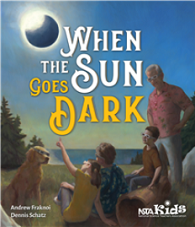New NSTA Book Shines Light on Solar Eclipses
By Carole Hayward
Posted on 2017-07-23
 A solar eclipse is coming on Monday, August 21, 2017! What a rare and exciting treat for your students who will get to experience this magical phenomenon. Of course after this amazing event, they will have plenty of questions. They will want to know why, how, and when will it happen again.
A solar eclipse is coming on Monday, August 21, 2017! What a rare and exciting treat for your students who will get to experience this magical phenomenon. Of course after this amazing event, they will have plenty of questions. They will want to know why, how, and when will it happen again.
When the Sun Goes Dark by Andrew Fraknoi and Dennis Schatz is the perfect resource to share with your students. The illustrated book tells the story of a 12-year-old’s experience of learning about solar eclipses from her grandparents.
“Grandma was telling us about the big event during their trip. First, the Sun looked like it had a little bite taken out of it. They had to use special glasses to be able to look at the Sun without hurting their eyes. Then that dark bite out of the Sun got bigger and bigger. When the Sun was almost covered, it looked like a diamond ring for a second. After that, not only the Sun but also the sky turned dark. The birds even stopped singing. The stars came out in the middle of the day. All of the people watching with my grandparents oohed and ahhed because there was a halo of light around the Sun that was very beautiful,” the narrator says.
This story, designed for readers in grades 5-8, explains the extraordinary science behind solar eclipses by using everyday objects such as a lamp, tennis ball, hula hoops, and ping pong balls.
Just as Grandma gives the narrator step-by-step instructions for creating an eclipse with a lamp’s light, teachers can illustrate the same lessons in the classroom. There are also many detailed illustrations showing the different phases of the moon; the constellations the Sun is in front of each month; and the paths of the Moon’s and the Sun’s orbits, for example.
“It turns out that the Sun and the Moon arrive at the crossing points together only twice a year. So we have a kind of ‘eclipse season’ roughly every six months when eclipses of the Sun and the Moon happen somewhere on Earth,” Grandpa explains.
The book discusses how astronomers can predict eclipses hundreds of years in advance and helps students to comprehend complicated astronomical concepts using vocabulary at their reading level.
When the Sun Goes Dark will answer students’ questions and stimulate their curiosity. The book comes with a glossary of terms and additional web resources that will help beginners to gain an in-depth understanding of both solar and lunar eclipses and inspire their interest in our magical solar system.
Fraknoi and Schatz are award-winning experts in astronomy and science education, and the authors of the NSTA book Solar Science: Exploring Sunspots, Seasons, Eclipses, and More.
Read a sample chapter here. This book is also available as an e-book.
Save
Save
Disclaimer: The views expressed in this blog post are those of the author(s) and do not necessarily reflect the official position of the National Science Teaching Association (NSTA).


